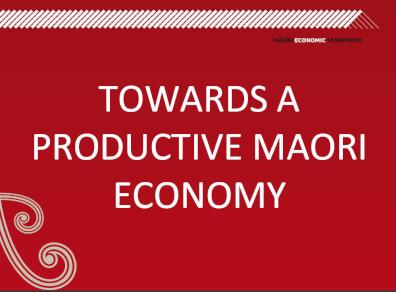June McCabe - Fresh Ideas for a Productive Economy

Notes for Fabians Seminar "Fresh Ideas for a
Productive Economy"
July 2011 - Legislative Chamber, NZ
Parliament
Developing science and innovation in the Maori economy – June McCabe Maori Economic Taskforce
June McCabe - Member Maori Economic Taskforce
June McCabe – Member Maori Economic Taskforce
Science and innovation
will deliver economic growth
Science and
innovation creates new opportunities:
• for economic
growth;
• improves our quality of life; and
• helps us make sense of the world we live in.
For science and innovation to create these opportunities, it is necessary to have a robust science and innovation system that is responsive to national needs and opportunities. Science and innovation are the foundations of New Zealand society. They improve our quality of life, help us understand and manage our environment, and are essential to our jobs and pastimes.
Science and innovation are important drivers for of New Zealand’s economic growth. Research improves productivity by creating ground-breaking technologies and new and better ways of doing things – essentially the definition of ‘innovation’. It enables new industries to emerge and existing ones to become more competitive. The World Economic Forum has identified innovation and business sophistication as the most important drivers of the income of advanced economies.
Investments in science and innovation have a major impact on the international competitiveness of a country and the living standards of its people. At the same time, science unlocks understanding and the solutions to many of the global problems all nations face – such as climate change, food and energy security, and an ageing population.
The New Zealand science and innovation landscape
The Prime Minister has placed
science at the heart of the Government’s economic agenda,
making clear that the Government’s objective is a
high-performing public science system which supports
economic growth, and a wider innovation system that
encourages firms to increase their investment in, take-up,
and application of research.
The Government has taken
steps to improve New Zealand’s science system and direct
government support where it can make the most difference. An
important initiative been taken to restructure government
funding to clarify priorities and provide a more direct
pathway for implementing them. The priority areas
are:
• high-value manufacturing and
services
• biological industries
• energy and minerals
• hazards and infrastructure
• environment
• health and
society
The Government has also increased support for
business R&D and introduced changes to give business better
access to public research.
The Ministry of Science and Innovation (MSI) is the lead agency charged with driving the science and innovation sector. It is also tasked with directing knowledge and technology transfer from the science and innovation sector to businesses and other research users. It was established on 1 February 2011, as part of a broader Government focus to boost the science and innovation sector’s contribution to economic growth.
Government funding within MSI’s Vote stands at $768 million (2010/2011 Budget): this includes funding to Crown Research Institutes (CRIs), other research funders, and business R&D.
The eight CRIs [1] play important, distinctive and central roles in New Zealand’s science and innovation system, and receive around $480 million of government funding a year. CRIs perform strategic research that can create opportunities for business and provide information and technology that contribute to the wellbeing of New Zealanders. CRIs also help meet the Government’s need for research to promote innovation in government services, inform policy development, and provide capacity to unexpected areas of need.
Vision Mātauranga
MSI’s Vision Mātauranga (VM) is “Unlocking the Innovation Potential of Māori Knowledge, Resources and People to assist New Zealanders to create a better future.” The VM Capability Fund provides specific funding to support for the development of skilled people and organisations undertaking research that encompasses Māori innovation and focuses on four thematic areas:
• contributing to economic growth through distinctive science and innovation
• Taiao: achieving environmental sustainability through iwi and hapū relationships with land and sea
• Hauora/Oranga: improving health and social wellbeing
• Mātauranga: exploring indigenous knowledge and science and innovation
About $5-6 million per year is funded through the VM Capability fund. Recent changes mean that VM is now integrated across MSI’s areas of responsibility and priorities. This means that VM it is not only a capability fund, but is now seen as a policy and operational tool to leverage Māori investment as an opportunity for Māori and the Government to work together, to unlock the Māori potential across all the science and innovation priority areas. This includes VM being reflected in all CRI Statements of Core Purpose, in which CRIs now deliver outcomes to three core groups – Government, industry and Māori, and amongst other objectives, to “enable the innovation potential of Māori knowledge, resources and people.”
The Māori economy and Science and Innovation
Significant opportunities exist
for Māori to be actively involved in the New Zealand
science, research, and innovation system, both in terms of
what Māori can offer the system, and in terms of what the
system has to offer Māori. Arguably, the current system
in New Zealand indicates a more passive Māori involvement
– for example, low participation rates, low educational
attainment rates in science, engineering, and technology,
and low rates of engagement between the research, science,
technology and innovation sector, and Māori organisations
and enterprises.
Leveraging Māori
investment
There are signs that this is starting to change, and while Māori organisations remain under-represented in the science, research and innovation sector, there is a stronger understanding and awareness of the opportunities. This includes the work that the Māori Economic Taskforce commissioned, with the report by BERL on ‘the Māori economy, science and innovation – scenarios of potential, opportunity and value’, released at the Māori Economic Summit.
Of the billions of dollars of assets held by Māori, at least half are estimated to be in the primary sector. There is a great opportunity for these primary sector businesses to step-up and grow, particularly through science, innovation and research and development. Science and new thinking will boost the value of the products firms produce, increase the profitability of production process and, ultimately, create extra value out of the resources Māori already have in the primary sector.
BERL science and innovation research
The BERL research investigated the benefits and opportunity costs to Māori and the wider New Zealand economy if investment in science and innovation is better aligned to the needs of the Māori economy. Investigating the science and innovation potential that Māori assets holders can realise is important because:
• science and innovation plays a critical role in economic development;
• there is a perception that innovative knowledge is not flowing between the science community and the Māori economy;
• current policy has arguably not delivered the investment in science and innovation necessary to enable the transformation of the Māori economy, and;
• investment in science and innovation needs to increase and be better aligned to the growth of the Māori economy. This growth should be driven by a closer relationship between government policy, funding, Māori enterprise and asset owners.
As BERL state, there are potential benefits and opportunity costs for the Māori economy in relation to its effective or ineffective engagement and alignment with New Zealand’s science and innovation effort. Connecting science and innovation with the Māori economy using scenarios modelled by BERL demonstrate the potential benefits (or costs) to the Māori economy, as well as the wider New Zealand economy over the period to 2061.
The key points generated from the various scenarios include:
• the ‘doing nothing’ scenario reveals high opportunity costs (in the economic as well as cultural and social sense) and few benefits.
• success in either productivity increases or improved export effort yield substantial benefits.
• a focus on investment in science and innovation that is not matched by the application and/or commercialisation of such effort results in only marginal gains.
• scenarios showing gains to the Māori economy also show value to NZ Inc, through gains in national GDP, employment and wider economic benefits.
In summary, based on the scenarios modelled in BERL’s research, successfully aligning New Zealand’s investment effort in science and innovation with the needs of the Māori economy potentially leads to [2] :
• an additional $12 billion per annum in GDP from the Māori economy by 2060
• 150,000 additional jobs per annum in the NZ economy by 2060
• with over 50,000 of these additional jobs in professional occupations
• and another 30,000 of these additional jobs in skilled trades occupations
• a boost to New Zealand’s per capita GDP in the range of $4,800 to $7,500 per annum by 2060
• an expansion of New Zealand’s export sector by an additional $12 billion per annum by 2060
• But a do nothing choice could see:
- 35,000
less jobs per annum in the New Zealand economy by
2060
- GDP from the Māori economy lower by $3bn per
annum by 2060
Further information detailing BERL’s research is available as part of the Māori Economic Taskforce publications.
Discussion at the Maori Economic Summit 5 May 2011
• What are the key
issues facing Māori in capturing the benefits of science
and innovation?
• What are the strengths, weaknesses,
opportunities and threats for a better alignment between the
Māori economy and science and innovation?
• What are
the barriers/opportunities/issues for engaging with the
science, research and innovation system, and what can Māori
do to enhance/mitigate these opportunities/issues or these
impacts?
• How can government support better engagement
between Māori, and Crown Research Institutes and wider
science and research community to capture the gains from
investment in science and innovation?
• How can Māori
gain better access to science, research and innovation
funding?
• What are the immediate priorities for
action?
• What are the long term focus areas for Māori
and New Zealand to capture the gains from investment in
science and innovation, particularly given the ‘scenarios
of potential, opportunity and value’ modelled in BERL’s
research?
Towards a productive
Maori Economy – key ideas to be presented at the Fabian
Seminar
• Shifting Paradigms – risk paradigms
and how to create value
• Collaboration and
Alignment – aggregation of assets, role of science and
innovation
• An eco-system to drive sustainable,
uniquely Maori (brand and enterprise) led export growth –
establishing a Financial Intermediary and an Innovation
Fund.
• Creating a Maori capital market -
aligning investors and issuers (Maori asset holders) –
i.e. demand and supply of capital for quality deal flow.
Footnotes:
1. The eight CRIs are AgResearch, Plant and Food Research, Institute of Environmental Science and Research, Scion, GNS Science, Industrial Research Limited, Landcare Research, and National Institute of Water and Atmospheric Research (NIWA)2. All values expressed in terms of 2010 dollars, with all figures representing the change on a baseline ‘business as usual’ projection of the New Zealand economy
 June McCabe – Maori
Economic Taskforce
June McCabe – Maori
Economic Taskforce
June has extensive experience in a
diverse range of sectors at governance and senior management
levels. Her career began in the public sector till 1993
after which she embarked on an investment and corporate
banking career. Over the last 5 years she has been involved
in management consultancy and the development of innovation
based funds.
She has also had extensive experience as a
Company Director since 1994 having held Board positions
including the Accident Compensation Commission, Housing New
Zealand, New Zealand Venture Investment Fund as a founding
Board member, Founding Chairman of The Leadership Institute,
Television New Zealand, Chairman of Payworks, a payment
technology business, Chairman of TalkingTech a global
technology company. She is currently on the Boards of Avanti
Finance, Northland District Health, Te Wananga o Aotearoa,
Te Waka Pupuri Putea Ltd and other private and not for
profit entities.
Due to her strong interest in Maori
economic development June over the years has been involved
in a number of Government advisory and policy forums at
senior levels including Chairman of the Maori Economic
Commission and more recently Chair of the Capital,
Investment and Enterprise work stream for the Maori Economic
Taskforce.



 Binoy Kampmark: Israel’s Anti-UNRWA Campaign Falls Flat
Binoy Kampmark: Israel’s Anti-UNRWA Campaign Falls Flat Peter Dunne: Luxon Gets Out His Butcher's Knife - Briefly
Peter Dunne: Luxon Gets Out His Butcher's Knife - Briefly Binoy Kampmark: Warring Against Encryption, Australia Is Coming For Your Communications
Binoy Kampmark: Warring Against Encryption, Australia Is Coming For Your Communications Gordon Campbell: On Fast Track Powers, Media Woes And The Tiktok Ban
Gordon Campbell: On Fast Track Powers, Media Woes And The Tiktok Ban Binoy Kampmark: Censorship Wars, Elon Musk, Safety Commissioners And Violent Content
Binoy Kampmark: Censorship Wars, Elon Musk, Safety Commissioners And Violent Content Gordon Campbell: On The Public Sector Carnage, And Misogyny As Terrorism
Gordon Campbell: On The Public Sector Carnage, And Misogyny As Terrorism